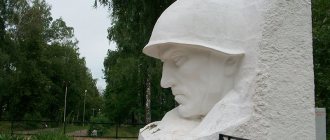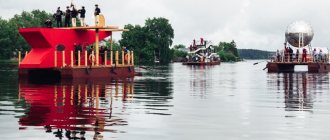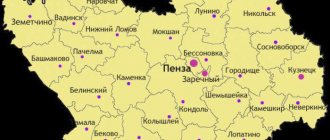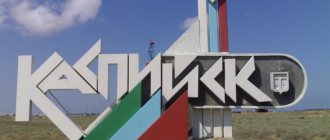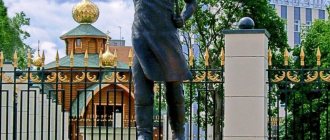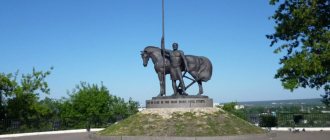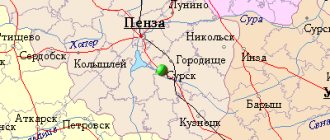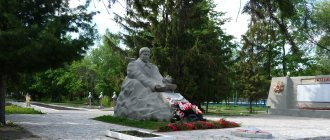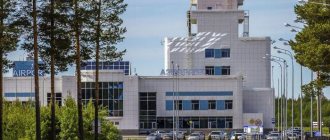Kuznetsk is a city in the Penza region of Russia. It has regional significance and forms the Kuznetsk urban district. The population is 83,400 people. It is located in central Russia, in the east of the Penza region. Its height is 254 meters above sea level. This is due to the influence of the Volga Upland. The Truev River flows through the city.
The area of the city is 2287 hectares. The population of Kuznetsk is gradually decreasing.
"Cathedral of the Ascension of Christ the Savior"
There are worthy shrines in Kuznetsk, but the main temple, undoubtedly, is the Cathedral of the Ascension of Christ the Savior. The snow-white church with green domes and a slender chapel fascinates and inspires certain thoughts.
In Soviet times, like many shrines, the temple was closed and looted. Its premises were used by atheists for various needs, but when the church was transferred to the diocese, painstaking work began on its restoration. Thanks to many believers, the temple was reconstructed, and its doors were opened to all Orthodox Christians. A Sunday school is open at the cathedral, there is a library, and the icon-painting center cordially welcomes you.
Location: Darwin Street - 45.
Sanatorium "Nadezhda"
A few kilometers from the city, on the banks of the Truev River, the Nadezhda sanatorium warmly welcomes guests, where you can not only get a good rest, but also improve your health. The sanatorium works with a wide range of profiles:
- Respiratory system.
- Musculoskeletal system.
- Nervous system.
- Metabolism.
- The cardiovascular system.
- Digestive organs.
- Urology.
- Diseases of the eyes, ears, nose, throat.
The building has cozy rooms with comfortable and modern furniture. Qualified specialists will help you solve any problem and will cordially come to your aid. It is worth noting that the territory of the sanatorium is a forest with magnificent natural landscapes.
Modern Kuznetsk is growing and developing at an active pace. The authorities and local residents are making every effort to improve their city.
"Church of the Kazan Icon of the Mother of God"
The extraordinary beauty of the dome, three-tier bell tower and original Russian style greets all guests who decide to visit the “Church of the Kazan Icon of the Mother of God”.
The heavenly colored domes give the appearance of the shrine purity and impeccability. This is one of the few temples that managed to avoid destruction and closure. Since its foundation, the church has opened its doors to all believers and those in need and regularly holds services.
Location: Chkalova street.
"Chapel of St. Paraskeva Martyr"
The Truev River, on which Kuznetsk is located, is shallow and small. There are a large number of springs around it, from which streams originate; they are one of the components of the river’s nutrition. According to ancient legend, an icon of the holy martyr Paraskeva appeared to people in the waters of one of these springs.
It was in this place that a chapel was erected in the style of wooden architecture, and the source was consecrated. Like many temples, the church was destroyed several times, but now the entire territory is well-groomed, a bathhouse is equipped, a bell tower is built, and a convenient approach to the source is organized. Every day the shrine is visited by a huge number of people. They draw holy water from the spring, take a dip in the bathhouse and light candles with prayers in the chapel.
Location: Artisanal Square.
Latest job center vacancies
The city requires workers in a variety of specialties. Lots of engineering vacancies. There are vacancies for PC operator. Salaries start from 11,163 rubles. There are quite a lot of vacancies at this salary. Most often these are various working specialties.
More expensive vacancies with a salary of up to 30,000 rubles, but most often in the region of 20 - 25 thousand rubles. Basically, these are vacancies in the service sector: managers, PC operators, administrators, customer service and others.
All this data is for June 2022.
"Museum of Local Lore"
In an ancient red brick mansion, built in the Art Nouveau style, is located the pearl of the city of Kuznetsk - the Museum of Local Lore, which is the main link between the past and the present.
The museum presents about 24,000 exhibits , which are divided into thematic sections and can tell and show visitors a lot of interesting things. The local history department will surprise you with the skeleton of a mammoth; historical exhibitions will show not only the life and life of the local people in ancient times, but will also take you into modern history.
Numerous exhibits will share events about the revolutionary time and the war years; a separate exhibition is dedicated to the life of home front workers in those terrible times. The museum staff conducts interesting excursions and conducts ongoing research work, adding new facts to the museum. Various folk festivals and folklore programs are also regularly held here.
Location: Lenin street - 270.
The history of the city of Kuznetsk from the very beginning
Beginning of Kuznetsk
IN THE 17TH CENTURY, the Middle Volga region (except for the banks of the Volga, which had long been owned by various rich, mainly Moscow monasteries) was a remote and remote outskirts of the Russian state. In the vast territories of the Saratov region there were no settlements, no large waterways, no land roads - only forests, swamps and wilderness.
It was precisely such places that were most suitable for fugitive people, of whom there were especially many under Peter I. Sleepy boyar Rus', poor and hungry, was awakened by the irrepressible energy of the new tsar, his desire to create a powerful Russian empire independent of foreign countries. Factories and manufactories began to be built, a regular army was created and a navy was born, there was a war for the Black and Baltic Seas, the Urals were being developed, a new capital of the state was growing in the swamps, trade, crafts and trades were intensively developing.
Reforms and innovations followed one after another. All this required enormous funds and large human resources, and they could only be pumped out from the people. The oppression has become unprecedentedly tougher. Taxes and taxes increased. They literally flogged the man for anything and everything they could: for the window in the hut, for the ice hole in the river, for being alive at all. They were forced to do hard work and become soldiers. Added to this was religious oppression.
From this absolute hell, the people fled to uninhabited, dense forests and steppes, to the outskirts of the state. And there he settled on free lands. One of these secret settlements appeared on the Truev River. This was around the 1680s. One fugitive settled, then another, a family moved in, several more joined - and on the left bank of the river, around Mary Hill, the settlement of Truevo grew up. The region here was rich, the forest was full of game and birds, and the deep river was full of fish. But since they had to live here secretly, all means of subsistence had to be obtained on the spot themselves. Therefore, all the necessary crafts developed in the village: they needed utensils - potters appeared; other crafts.
In search of new people for the army and construction work, Peter I scoured all the nooks and crannies of his state. Secret settlements were opened, their inhabitants were attributed to the boyars, and landowner bondage again entangled people.
Peter 1 granted the Saratov province, where Truevo was adjacent, to the boyars Naryshkin - one of his closest relatives and associates. The settlement of Truevo went to the boyar Vasily Fedorovich Naryshkin. He founded the Church of the Resurrection of Christ here, and it was built at the foot of the Mars. was opened on February 7, 1699, as stated in the Decree of the Patriarch. This day began to be considered the official founding day of the village of Truevo-Voskresenskoye - by this time there were 15 peasant and 5 bobyl households, 4 church houses.
Later, Truevo-Voskresensk was named after the boyar Naryshkin. From its original location it began to grow to the west and south. Judging by the census books of 1717-1718, there were already 185 households of yasak peasants (yasak, i.e. non-Russian, taxed in kind) and another 103 households of alien peasants who came here from the Moscow, St. Petersburg, Voronezh, Kazan and Nizhny Novgorod provinces .
In 1719, landowners G. Ablyazov, V. Neklyudov, A. Kiselev and others complained to the tsar that the village had grown to about 5 thousand people and were increasingly engaged in robbery.
In 1720, the village of Naryshkino was called the patrimony of the steward G.F. Griboyedov and is already listed in the Penza district. By this time, the region began to be intensively populated. Peter 1 granted lands from “wild places” to service people and monasteries, and they settled transferred peasants here. The colonial wave of landowners and free Russian people forced the Mordovians to leave the central provinces - Penza, Tambov and Nizhny Novgorod, and they also settled in some part in Naryshkin or its environs.
Fugitive peasants continued to flock here. Peter I also sent unreliable archers here. Two of them, natives of Rostov-on-Don, became the founders of the leather craft in Naryshkin.
From the estates of the Penza region, the nobility with their peasants gradually moved south - into the steppes and wilderness of the Saratov region. Therefore, most of the villages in Kuznetsk district were founded by landowners-transfers. Of the 75 villages and hamlets of the district that arose before the time of the first census, that is, approximately until 1722, no less than forty-two were founded by landowners.
In 1727-1728 The authorities again receive complaints that thieves and robbers, who find refuge near Naryshkin, travel in crowds, burn and ruin many villages and hamlets, torture and kill landowners and peasants, take away their belongings and take away their livestock.
In 1732, Naryshkno was called a palace village. In 1745 there were 146 households here, and the village was owned by the landowner Buturlin. The population grew rapidly, crafts, especially blacksmithing, developed rapidly, trade and exchange of goods began. Fairs began to be held regularly in Naryshkin. Soon the residents no longer needed to engage in farming; they began to switch to year-round crafts.
On November 10, 1780, by Decree of Catherine II, the village of Naryshkino was renamed the city of Kuznetsk. The city’s coat of arms, approved in 1781, depicts an anvil and a hammer on a red field, “...before,” as the description of the coat of arms says, “this city is filled with blacksmiths, from whom it received its handicrafts and its name.”
When the city was founded, soldiers were stationed at its outposts who asked arriving people: “Where are you going?” And they beat with a whip everyone who said that they were in Naryshkino, saying: “Say: I’m going to the city of Kuznetsk, and not to the village of Naryshkino!”
Kuznetsk grew quickly. New streets appeared in it, large houses of merchants and service people, shops and warehouses grew in the center. But there was also such a fact.
In 1786, Catherine I was supposed to travel around the state with a stop in Kuznetsk. For the construction and repair of the road, it was ordered to provide one horse for every 30 souls and one cab for each pair. Kuznetsk supplied 80 horses and 40 cabs, and in addition, it was “paid to people of various ranks on horseback and on foot who were with the land surveyor for cutting a ditch from Kuznetsk to Petrovsk along the main road - 612 rubles. Paid to people of different ranks on horseback and on foot for the supply of then plowing forests, straw, stones and sand - 100 rubles. Somehow, wood, straw, sand and stones for moss on the square areas of two gates were given for the bridge - 630 rubles.” These lines from the document say that in Kuznetsk and its environs there was terrible mud; it was necessary to fill it up first with branches and straw, and on top with sand and stones. Horses on the streets were stuck up to their bellies with carts, horses were pulled out with levers, and they were often mutilated. The central streets of the city were paved with stone only in 1900.
It was not by chance that Kuznetsk became a city. More recently, the Pugachev uprising was suppressed with great effort. Pugachev entered Penza, his troops hanged merchants and landowners on Mary in Naryshkin. The queen was frightened by popular unrest and hastily strengthened local power, especially in the outskirts. The queen sent troops into the newly formed cities, imposed new taxes on the population to support soldiers, and, if necessary, local authorities could quickly suppress any unrest. In addition, the village of Naryshkino met all the requirements for county centers. By 1780, the population of Naryshkino-Kuznetsk was 2,271 people. For comparison: at that time 4,309 people lived in Saratov, 938 in Tsaritsyn (now Volgograd), and 293 in Petrovsk.
That is, the population was sufficient to carry out significant production. In addition, Kuznetsk not only fully supported itself, fed, watered, clothed, but also produced marketable products for export. A highway from Orenburg to Moscow passed near the city. There were various crafts and even industry. Already at that time, fairs were constantly taking place in Kuznetsk, and there was brisk trade. Back in the 1760s, Naryshkino was a large grain trading center, through which bread from Penza places went to Saratov.
Another figure is also noteworthy: if in total there were 13,769 souls in the cities of the province, then in the Kuznetsk district there were 19,989 people.
To govern the city, public places were opened: the city magistrate, the Duma, the verbal court, the orphan's court, the police department and the treasury. A mayor, a solicitor, a mayor, two burgomasters, four rotmans, a verbal judge, two conscientious ones, a merchant and a bourgeois elder were appointed and elected.
From 1780 to 1812 the position of mayor was occupied by Pyotr Kirillov, Khlebnikov, Andrey Koshkadayev, Efim Titklev, Alexey Simbirin, Ilya Bezrukov, Vasily Klimov, Kirill Patrikeev, Shchipanov, Dyakonov. The first elders were: from the merchants - Lukyan Dementyev, from the burghers - Nikita Lukyanov. In 1797, the city was divided into 2 police units, with a total of 1083 houses.
In 1794, the “Special Geometric Plan of the Saratov Province of the City of Kuznetsk” was prepared.
From the description of this plan it is clear that according to the last, fifth revision in Kuznetsk there were: merchants - 891 souls, townspeople and guilds - 1528 souls, a total of 2419. The city then consisted of almost only one street - Bolshaya (now Rabochaya). Pages: First Previous 5 Next Last
Monument to "Steam Locomotive"
The railroad played a significant role in the history of the city. Therefore, grateful residents erected a monument to the Steam Locomotive in the Zheleznodorozhnikov park. A powerful diesel locomotive, to which the carriage was attached, was installed on the rails. Many city guests consider it an honor to take a photo near this landmark.
Location: Belinsky street - 126a.
"Monument to Home Front Workers"
The war of 1941–1945 brought with it a lot of troubles and destruction. Many heroes defended their homeland. But for the Great Victory, home front workers made no small contribution, who did their best to help those who were on the battlefields. It is for the home front workers that a monument was erected in the city park. The sculpture is one of the components of the museum and memorial complex.
Natural conditions
Kuznetsk is located on a hill in central Russia. The climate is temperate, with an annual precipitation of 627 mm. Winters are cool. The lowest average temperature is observed in February - 9.8 °C. The average annual temperature is + 5.3 °C. Summer is moderate. Precipitation at this time of year is often showery.
The city is located in a forest zone. To the north of the city borders there is a coniferous forest. No serious deposits have been discovered in this district. There are natural oil deposits. The most widespread are sands, sometimes peat bogs. There are places where clays, loams, and mineral dyes occur.
To the north of the city there is a nature reserve: the Volga forest-steppe.
Museum and memorial complex "Hill of Glory"
“The Hill of Glory” is installed on the highest hill of the city and is dedicated to the memory of the fallen residents of Kuznetsk in the Great Patriotic War of 1941 - 1945.
Several statues and the “Museum of Military Glory” are located at the foot of the memorial. An avenue of busts and engraved plaques commemorate famous names. On the hill itself, three granite wars gracefully rise, and at their foot an eternal flame burns.
"Park of Culture and Recreation Neskuchny Garden"
In the very center of the city, the “Park of Culture and Recreation” hospitably welcomes all vacationers. This is a favorite place for both city residents and visitors. At any time of the year, you can stroll along the asphalt paths and admire the natural beauty.
The park is especially in demand in the summer; a holiday extravaganza has been created here for little visitors: rides and ice cream, a cafe and a sports ground. There are benches throughout the park where you can relax quietly in the shade of the treetops.
Location: Komsomolskaya street - 47.

